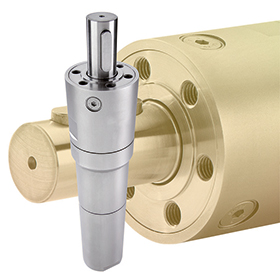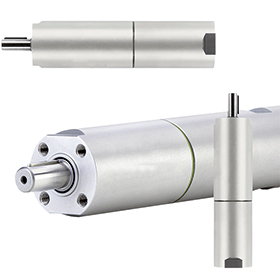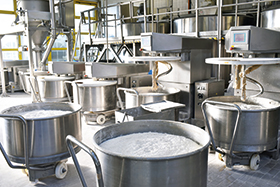
Automated processes are standard practice in the food industry. Production efficiency is not the only motivation, hygiene also plays a key role in the food industry. Deprag Schulz product manager, Dagmar Dübbelde, discusses how to design a drive to meet these requirements and incorporate both these goals.
Question: How are high standards of hygiene met by Deprag?
Answer: In order to ensure that the right drive is selected to meet the high requirements for hygiene in the food industry, we usually recommend our Advanced Line air vane motors. All their external components are made from stainless steel and are impervious to normal cleaning agents. The smooth surface of these air motors is easy to clean. The drives are so well sealed, with durable long-life radial shaft seals, that no air can escape and equally no dirt, water or other solutions can penetrate the motor. The motors are even resistant to water penetration from commonly used cleaning spray systems. A wet environment is no concern for this motor. It can even be used underwater as in the case of many stirring applications. All our Advanced Line stainless steel motors are lubricated with food grade USDA-H1 grease and can be operated oil-free. A power reduction of approximately 10 to 20%, based on the technical data stated in the product catalogue, should be taken into account when designing drives for oil-free operation.

Question: Does an air motor need to boast other features for such applications?
Answer: Yes. In many applications, condensation can form in air supply lines. It is therefore advisable that measures are taken to ensure that the motor is not located at the lowest point in the system and that it can be flushed out with water. Many users take precautionary measures, not only relating to the layout of the motor in their system, but also concerning the use of water separators or dryers in front of the drive. If all this is not possible, then we recommend a special coating for those components within the motor’s interior which are made from stainless steel. This is because there is a limit to the use of stainless steel for heavy duty, high-speed internal parts. This CWL coating provides insensitivity to corrosion.
Question: Do you have any examples of where your motors can be used in the food industry?
Answer: The food industry applications are endless. Some examples are stirring dough, moving and cutting sheets of dough, rotating pork belly skewers, mixing sausage meat or unwinding sausage skins. I will describe a few applications in more detail, such as the use of our Advanced Line air motor in an agitator for the production of fruit juice. Our 300 W air motor drives a propeller stirrer in a magnetic agitator at the speed of 700 rpm.
We also have the ideal drive for high-torque requirements in industrial agitators. Our Advanced Line high-torque motors generate immense power in the smallest of spaces. The 900 W high-torque motor, with a nominal speed of 22 rpm, overcomes a starting torque of 585 Nm and has a maximum diameter of 63 mm.
Another application can be found in grinding mills and conveying systems for grain processing. In this case, the focus is on dust generation and explosion prevention. All our Advanced Line motors are ATEX certified for use in potentially explosive environments. You will even find our motors used in the processing of meat, for example in a semi-automatic assembly system for the manufacture of kebab skewers. In the skewer unit, two air motors are used to drive belts which pierce a wooden skewer through pieces of meat, onion and pepper. Pressure at the skewer is 38 kg and therefore a high-power air motor with compact design is ideally suited to this application.

Question: What advantages does an air motor have over an electric motor in such applications?
Answer: There are many arguments in favour of using an air motor. One of the main advantages is its high power density. Depending on the design, an air motor has only a fifth of the mass of an electric motor, or a third of its size. This is particularly significant when using a handheld device, but of course also for robotic systems where the drive moves with the robot arm.
Heat also leaves the air motor cold. In critical settings, compressed air is an unproblematic source of energy – it does not compare to the dangers of electricity. The power output from the air motor over wide torque ranges is almost constant. Air motors can therefore be optimally operated in a wide field of fluctuating loads. There is no problem with load being applied on the air motor until standstill, and no damages are incurred. This means it is less apt to stalling. After reduction of the load, it will run again immediately, any number of successive times. Air motor power can be adapted simply by adjusting the operating pressure. The speed is reduced smoothly by throttling the air volume. Throttling supply air is recommended when torque should also be significantly reduced. Exhaust air throttling should be chosen to reduce speed without any serious influence on the torque.
Question: Air motors are often seen to be less efficient compared to electric motors. Can you comment on this statement?
Answer: Air motors and electric motors cannot be compared on a one-to-one basis. The efficiency of a drive always depends on the conditions of the application. Let me use this example to explain: A motor which reaches speeds of 450 rpm is needed for a packaging machine. A torque of 25 Nm is applied at reduced speed over a long period of time to secure the packaging tape. Electric motors cannot be loaded over a long period of time without running the risk of overheating. Therefore, for this packaging machine, an electric motor would need to withstand high loads and as a result would need to be 1170 W (25 Nm x 450 rpm divided by 9550). It is a completely different story with the air motor. Due to the favourable torque characteristics of air motors, a lower powered drive will suffice. You could select an air motor with a nominal torque of 15 Nm and nominal speed of 275 rpm. Since the working torque is below that of the nominal torque, the air motor runs close to idle speed at 450 rpm under light load. The power required for this air motor is therefore only 430 W. The energy balance of an air motor is seen in a totally different light when you consider that the air motor needed for this packaging machine would require only a third of the power of an electric motor.

Question: Deprag Schulz can reflect on decades of experience in the field of air motors. They have a wide range of high quality, globally popular industrial drive solutions. Are the Advanced Line motors a special solution for food industry applications?
Answer: It is true that our engineers have continued to optimise our air motors over the decades and our standard programme has been adjusted to meet the needs of our customers. The Advanced Line motors belong to our Deprag catalogue programme. Our customers benefit from long-established reliable drive solutions for the food industry and medical technology. We are able to offer these motors in a wide power range from 20 W to 1,6 kW, combined with a variety of planetary gears from our own production with speeds of 7 to 24 000 rpm. This outstanding spectrum of stainless steel motors has made us a market leader in this segment. You can find the ideal solution for every performance requirement. Thanks to our development specialists and a high level of vertical integration, we are able to react flexibly to customer requirements when a certain design, such as a specific flange connection or special spindle request, is not available off the shelf. 85% of our manufactured drives are customer-specific solutions based on standard components.

© Technews Publishing (Pty) Ltd | All Rights Reserved